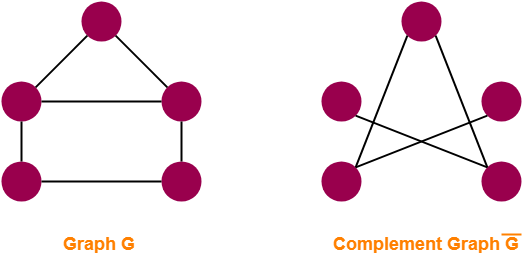Complement Of Graph-
Complement of a simple graph G is a simple graph G’ having-
- All the vertices of G.
- An edge between two vertices v and w iff there exists no edge between v and w in the original graph G.
Complement Of Graph Example-
The following example shows a graph G and its complement graph G’-

Relationship Between G & G’-
The following relationship exists between a graph G and its complement graph G’-
1. Number of vertices in G = Number of vertices in G’.
| |V(G)| = |V(G’)| |
2. The sum of total number of edges in G and G’ is equal to the total number of edges in a complete graph.
|
|E(G)| + |E(G’)|
= C(n,2) = n(n-1) / 2 |
where n = total number of vertices in the graph
Important Terms-
It is important to note the following terms-
- Order of graph = Total number of vertices in the graph
- Size of graph = Total number of edges in the graph
Also Read- Types of Graphs in Graph Theory
PRACTICE PROBLEMS BASED ON COMPLEMENT OF GRAPH IN GRAPH THEORY-
Problem-01:
A simple graph G has 10 vertices and 21 edges. Find total number of edges in its complement graph G’.
Solution-
Given-
- Number of edges in graph G, |E(G)| = 21
- Number of vertices in graph G, n = 10
We know |E(G)| + |E(G’)| = n(n-1) / 2.
Substituting the values, we get-
21 + |E(G’)| = 10 x (10-1) / 2
|E(G’)| = 45 – 21
∴ |E(G’)| = 24
Thus, Number of edges in complement graph G’ = 24.
Problem-02:
A simple graph G has 30 edges and its complement graph G’ has 36 edges. Find number of vertices in G.
Solution-
Given-
- Number of edges in graph G, |E(G)| = 30
- Number of edges in graph G’, |E(G’)| = 36
We know |E(G)| + |E(G’)| = n(n-1) / 2.
Substituting the values, we get-
30 + 36 = n(n-1) / 2
n(n-1) = 132
n2 – n – 132 = 0
Solving this quadratic equation, we get n = 12.
Thus, Number of vertices in graph G = 12.
Problem-03:
Let G be a simple graph of order n. If the size of G is 56 and the size of G’ is 80. What is n?
Solution-
Size of a graph = Number of edges in the graph.
Given-
- Number of edges in graph G, |E(G)| = 56
- Number of edges in graph G’, |E(G’)| = 80
We know |E(G)| + |E(G’)| = n(n-1) / 2.
Substituting the values, we get-
56 + 80 = n(n-1) / 2
n(n-1) = 272
n2 – n – 272 = 0
Solving this quadratic equation, we get n = 17.
Thus, Number of vertices in graph G = 17.
In other words, Order of graph G = 17.
To gain better understanding about Complement Of Graph,
Next Article- Walks in Graph Theory
Get more notes and other study material of Graph Theory.
Watch video lectures by visiting our YouTube channel LearnVidFun.